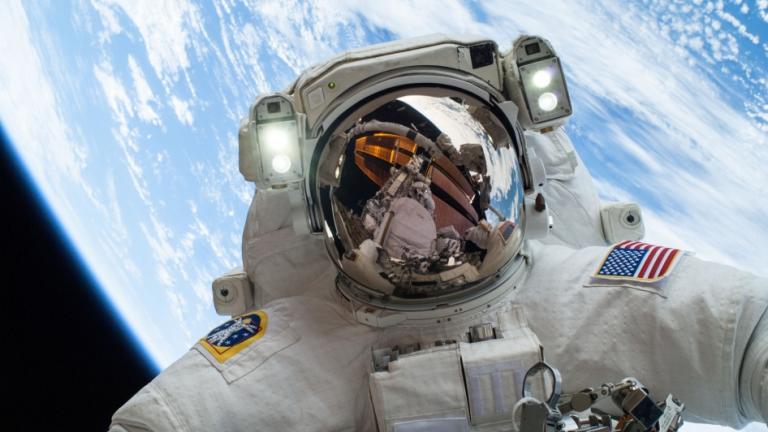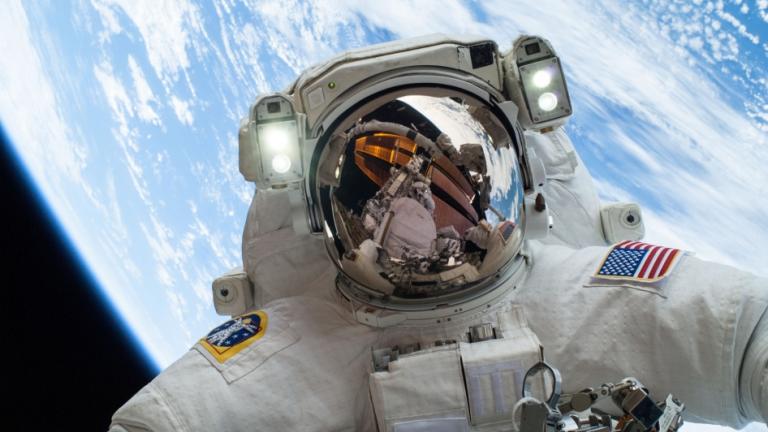He became a YouTube sensation covering David Bowie’s Space Oddity on the International Space Station. But Chris Hadfield’s journey from Canadian test pilot to commander of the International Space Station is a story of determination and hard work. Col. Hadfield joins us to talk about his new autobiography, An Astronaut's Guide to Life on Earth. Read excerpts from the book:
Introduction
Mission Impossible
The windows of a spaceship casually frame miracles. Every 92 minutes, another sunrise: a layer cake that starts with orange, then a thick wedge of blue, then the richest, darkest icing decorated with stars. The secret patterns of our planet are revealed: mountains bump up rudely from orderly plains, forests are green gashes edged with snow, rivers glint in the sunlight, twisting and turning like silvery worms. Continents splay themselves out whole, surrounded by islands sprinkled across the sea like delicate shards of shattered eggshells.
Floating in the airlock before my first spacewalk, I knew I was on the verge of even rarer beauty. To drift outside, fully immersed in the spectacle of the universe while holding onto a spaceship orbiting Earth at 17,500 miles per hour—it was a moment I’d been dreaming of and working toward most of my life. But poised on the edge of the sublime, I faced a somewhat ridiculous dilemma: How best to get out there? The hatch was small and circular, but with all my tools strapped to my chest and a huge pack of oxygen tanks and electronics strapped onto my back, I was square. Square astronaut, round hole.
The cinematic moment I’d envisioned when I first became an astronaut, the one where the soundtrack swelled while I elegantly pushed off into the jet-black ink of infinite space, would not be happening. Instead, I’d have to wiggle out awkwardly and patiently, focused less on the magical than the mundane: trying to avoid snagging my spacesuit or getting snarled in my tether and presenting myself to the universe trussed up like a roped calf.
Gingerly, I pushed myself out headfirst to see the world in a way only a few dozen humans have, wearing a sturdy jetpack with its own thrusting system and joystick so that if all else failed, I could fire my thrusters, powered by a pressurized tank of nitrogen, and steer back to safety. A pinnacle of experience, an unexpected path.
Square astronaut, round hole. It’s the story of my life, really: trying to figure out how to get where I want to go when just getting out the door seems impossible. On paper, my career trajectory
looks preordained: engineer, fighter pilot, test pilot, astronaut. Typical path for someone in this line of work, straight as a ruler. But that’s not how it really was. There were hairpin curves and dead ends all the way along. I wasn’t destined to be an astronaut. I had to turn myself into one.
1
The Trip Takes a Lifetime
One morning a strange thought occurs to me shortly after waking: the socks I am about to put on are the ones I’ll wear to leave Earth. That prospect feels real yet surreal, the way a particularly vivid dream does. The feeling intensifies at breakfast, when reporters jostle each other to get a good photo, as though I’m a condemned man and this is my last meal. Similarly, a little later on, when the technicians help me into my custom-made spacesuit for pressure checks, the joviality feels forced. It’s the moment of truth. The suit needs to function perfectly—it is what will keep me alive and able to breathe if the spacecraft depressurizes in the vacuum of space—because this isn’t a run-through.
I am actually leaving the planet today.
Or not, I remind myself. There are still hours to go, hours when anything could go wrong and the launch could be scrubbed. That thought, combined with the fact that I’m now wearing a diaper just in case we get stuck on the launch pad for a very long time, steers my interior monologue away from the portentous and toward the practical. There’s a lot to remember. Focus.
Once everyone in the crew is suited up, we all get into the elevator in crew quarters to ride down to the ground and out to our rocket ship. It’s one of those space-age moments I dreamed about as a little kid, except for the slow—really slow—elevator. Descent from the third floor takes only slightly less time than it does to boil an egg. When we finally head outside to walk toward the big silver Astro van that will take us to the launch pad, it’s that moment everyone knows: flashbulbs pop in the pre-dawn darkness, the crowd cheers, we wave and smile. In the van, we can see the rocket in the distance, lit up and shining, an obelisk. In reality, of course, it’s a 4.5-megaton bomb loaded with explosive fuel, which is why everyone else is driving away from it.
At the launch pad, we ride the elevator up—this one moves at a good clip—and one by one we crawl into the vehicle on our hands and knees. Then the closeout crew helps strap me tightly into my tiny seat, and one of them hands me a note from Helene, telling me she loves me. I’m not exactly comfortable—the spacesuit is bulky and hot, the cabin is cramped, a distinctly un-cushion-like parachute and survival kit is wedged awkwardly behind my back—and I’m going to be stuck in this position for a few hours, minimum. But I can’t imagine any place else I’d rather be.
After the ground crew checks the cockpit one last time, says goodbye and closes the hatch, it’s time for pressure checks of the cabin. Banter ebbs: everyone is hyper-focused. This is all about increasing our chances of staying alive. Yet there’s still a whiff of make-believe to the exercise because any number of things could still happen—a fault in the wiring, a problem with a fuel tank—to downgrade this to just another elaborate dress rehearsal.
But as every second passes, the odds improve that we’re going to space today. As we work through huge checklists—reviewing and clearing all caution and warning alarms, making sure the multiple frequencies used to communicate with Launch Control and Mission Control are all functional—the vehicle rumbles to life: systems power up, the engine bells chime for launch. When the auxiliary power units fire up, the rocket’s vibration becomes more insistent. In my earpiece, I hear the final checks from the key console positions, and my crewmates’ breathing, then a heartfelt farewell from the Launch Director. I go through my checklist a quick hundred times or so to make sure I remember all the critical things that are about to happen, what my role will be and what I’ll do if things start going wrong.
And now there are just 30 seconds left and the rocket stirs like a living thing with a will of its own and I permit myself to move past hoping to knowing: we are going to lift off. Even if we have to abort the mission after a few minutes in the air, leaving this launch pad is a sure thing.
Six seconds to go. The engines start to light, and we sway forward as this huge new force bends the vehicle, which lurches sideways then twangs back to vertical. And at that moment there’s an enormous, violent vibration and rattle. It feels as though we’re being shaken in a huge dog’s jaws, then seized by its giant, unseen master and hurled straight up into the sky, away from Earth. It feels like magic, like winning, like a dream.
It also feels as though a huge truck going at top speed just smashed into the side of us. Perfectly normal, apparently, and we’d been warned to expect it. So I just keep “hawking it,” flipping through my tables and checklists and staring at the buttons and lights over my head, scanning the computers for signs of trouble, trying not to blink. The launch tower is long gone and we’re roaring upward, pinned down increasingly emphatically in our seats as the vehicle burns fuel, gets lighter and, 45 seconds later, pushes past the speed of sound. Thirty seconds after that, we’re flying higher and faster than the Concorde ever did: Mach 2 and still revving up. It’s like being in a dragster, just flooring it. Two minutes after liftoff we’re hurtling along at six times the speed of sound when the solid rocket boosters explode off the vehicle and we surge forward again. I’m still completely focused on my checklist, but out of the corner of my eye, I register that the color of the sky has gone from light blue to dark blue to black.
And then, suddenly, calm: we reach Mach 25, orbital speed, the engines wind down, and I notice little motes of dust floating lazily upward. Upward. Experimentally, I let go of my checklist for a few seconds and watch it hover, then drift off serenely, instead of thumping to the ground. I feel like a little kid, like a sorcerer, like the luckiest person alive. I am in space, weightless, and getting here only took 8 minutes and 42 seconds.
Give or take a few thousand days of training.
Excerpted from the book AN ASTRONAUT’S GUIDE TO LIFE by Col. Chris Hadfield. Copyright © 2013 by Col. Chris Hadfield. Reprinted with permission of Little, Brown and Company.
Watch Commander Hadfield sing David Bowie’s Space Oddity, on board the International Space Station:
In the following video, Hadfield talks about sleeping in space:
Watch Hadfield demonstrate how to cook spinach in space:




